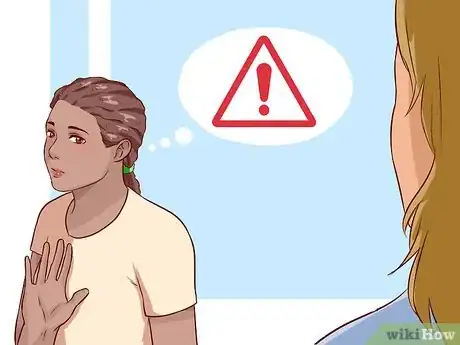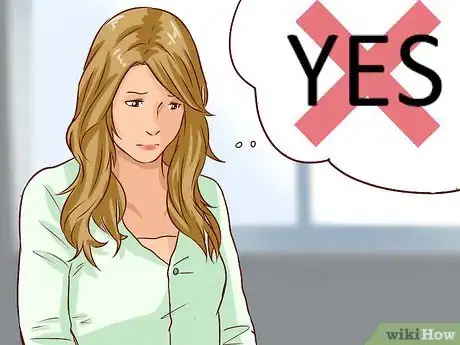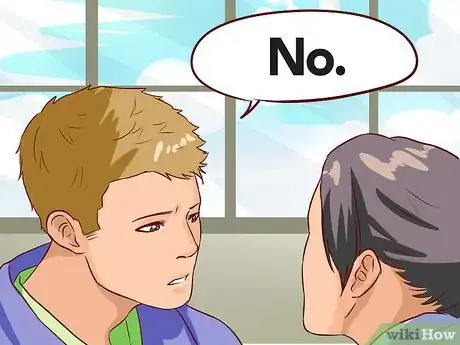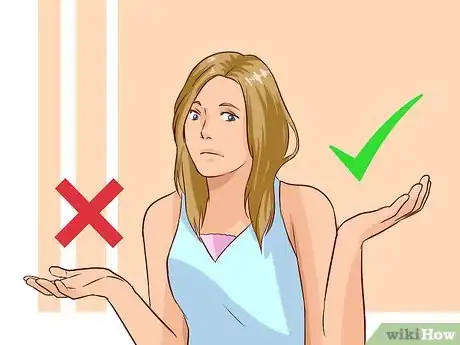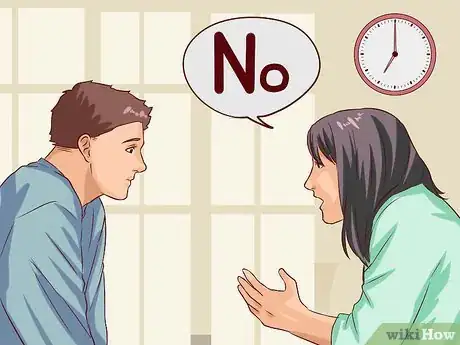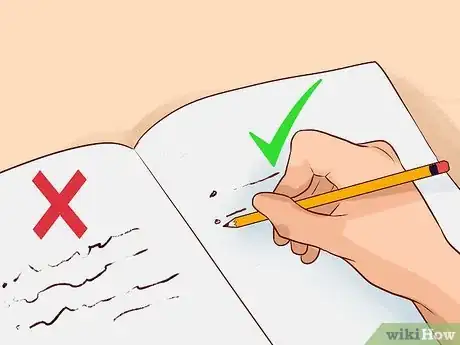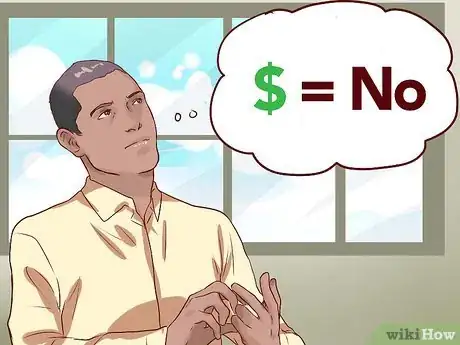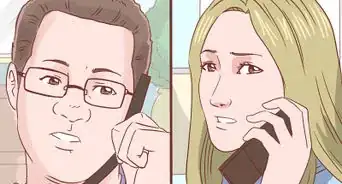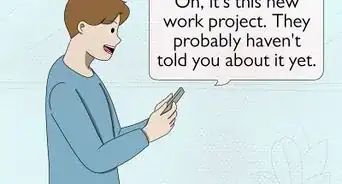This article was co-authored by Trudi Griffin, LPC, MS. Trudi Griffin is a Licensed Professional Counselor in Wisconsin specializing in Addictions and Mental Health. She provides therapy to people who struggle with addictions, mental health, and trauma in community health settings and private practice. She received her MS in Clinical Mental Health Counseling from Marquette University in 2011.
There are 10 references cited in this article, which can be found at the bottom of the page.
This article has been viewed 91,150 times.
Knowing when to say "no" takes practice. Learning this skill can help keep you safe and allow you to build and maintain strong and healthy relationships. It can also help you know when to take the best opportunities that come your way, and to ignore those that are a waste of your time and talents. In order to know when you’re doing a good thing by saying no, it is important to learn more about your personal limits as well as to understand how to identify opportunities that are too good to be true.
Steps
Knowing Your Limits
-
1Reflect on your personal boundaries. A boundary is the line between what is OK and what is not OK. Consider your physical, emotional, and mental boundaries. [1] Physical boundaries involve privacy, space, and your body. This may be dictated both by your personal preferences and philosophies, your culture, and things such as your faith.
- For example, what kinds of activities you are willing to engage in on a first date. One person may be only comfortable with a kiss, while another is eager for more. (One is not better or worse than another, just different.)
- Boundaries can change. Time, circumstances, and so on can change what a person's boundaries are one way or another.
- Emotional boundaries are where you set the line between your responsibility for your own feelings versus others’ feelings. Mental boundaries involve your thoughts, values, and opinions.[2]
- You might find it helpful to write down your thoughts and feelings about your personal boundaries. Then you can return to the list in the future to help you make difficult decisions.
-
2Reflect on any times where you have said "yes" but regretted it. Take time to write down or otherwise reflect upon any times in the past that you have gone beyond what makes you feel comfortable. Ask yourself about the people involved and the situations where these things happened. Examining past events this way can help you to make better choices next time.Advertisement
-
3Listen to your feelings. Your feelings have a great deal to tell you about where you should set your limits. Anything that makes you feel resentment or discomfort should raise a red flag for you. Sometimes anger, too, can be the result of going beyond your personal limits.[3] If a situation or personal interaction makes you feel resentful or a level of discomfort that is not reasonable, then ask yourself what is causing that feeling.
- Do you feel taken advantage of or not appreciated? Are you responding that way because of someone else’s expectations about you? Feelings of resentment and discomfort can both be signals that you are not setting limits where you should.[4]
-
4Give yourself permission to stay within your self-defined limits. Many people who are learning about their own limits so they can know when to say no find that they experience feelings like self-doubt, fear, and guilt.[5] Remember that it is not selfish to say no, and that saying no can be a way to take care of your health and well-being.[6]
-
5Try a "boundary building" exercise. These exercises can help you see what having "strong but flexible" boundaries – what experts say are the best kind – feels like. Psychologists have developed exercises you can use to help visualize your boundaries are so that you will know the right times to say no.
- Choose a type of boundary you are interested in exploring – mental, physical, or emotional. Focus on this type of boundary while you do this exercise.
- Close your eyes and imagine you are in the middle of a circle you have drawn around yourself. Make the circle as big or small as you want – give yourself the amount of space that feels best for you.
- Imagine your circle turning into a wall. Make your imaginary wall out of anything you like – thick glass, grey cement, bricks and mortar – just make sure that your wall is strong.
- Now imagine yourself having the power to be in control of the wall. You can melt a temporary hole to let something in or out, you can open a tiny window, or you can pull a brick out of the wall to make an opening. Think about being in control of your wall, and about being safe and powerful inside the circle you have built.
- Stay inside the wall for one minute.
- Repeat the exercise once a day.[7]
-
6Practice saying no. Knowing when to say no takes time and practice, and over time you can learn to hone your skills so that you are better able to recognize the situations where you can and should say no. Practice saying no clearly so that the person you are speaking to isn’t confused and thinks you will say yes later. Give a brief but clear reason for saying no, and be honest rather than using an excuse.
- Be respectful when you say no – you can let the person or organization know that you value them and what they are doing but that you are not able to do what they ask.[8]
Identifying Your Personal Priorities
-
1Identify your priorities. In order to make a good decision about when to say no, you will want to identify what your own personal priorities are in life. To do this, take some time to reflect on the top 10 things that you feel make your life worth living. Don't worry about choosing things you "should" choose - this list is about what makes you happy.
- After completing the list, put it away.
- A few days later, write another list (without looking at your first list). Put that list away.
- Repeat again a few days later.
- Look at all three lists and combine them into one. Note where ideas repeat, and combine items that seem similar to you.
- Rank your priorities.[9]
- Use the final list as a resource to help you make decisions by asking yourself how different decisions might effect your priorities.
-
2Say no when you already have too much to do. If you are feeling overloaded already, saying yes to one more thing can have very negative consequences for the work you are doing, for your physical and mental wellbeing, and for your relationships. Small things in your work might start to slip, you might get sick or have a breakdown, or your relationships with friends and family might suffer.[10] [11]
- Remember that your health and well-being is ultimately more important than taking on another task.
-
3Be realistic about your own capacities. Business experts say that people are often too optimistic about how quickly and well they will be able to accomplish something. Take the time to reflect honestly about whether or not you have the skills, abilities, and time to do what is being asked. Don’t say yes thinking that you can "change the rules" later on. Be clear and honest from the start with yourself and others so that you know when to say no – and know when the perfect time to say yes comes along.
-
4Take the time you need to make the right decision. If you are not sure about whether saying yes is a good idea, honestly tell the person asking that you are not sure. Then take some time – even a few days – to reflect, research, and seek advice.[12]
-
5Make a pro and con list keeping your long-term goals in mind. Sit down and make a list – on paper, on your computer, or even on your mobile phone – of the reasons to say yes and the reasons to say no to the opportunity before you. Doing this can help you make a good decision because you will be able to see if the "great" opportunity you initially feel you can’t pass up is as great as it really seems.
- When you look at your list, think about where you want to go in the future. If you say yes now, will that decision help you get where you want to go?[13]
Identifying Unprofitable Opportunities
-
1Calculate the "opportunity cost" of saying no. If the opportunity is business-related or involves financial decisions – anything from whether to take on a new babysitting client to whether to get your groceries delivered instead of going to the store yourself – you will want to calculate the "opportunity cost."
- Start by calculating how much one hour of your time is worth when you spend that hour doing paid work.
- For each opportunity that presents itself, calculate how much the opportunity will cost as part of your decision about whether or not to say no.[14]
- For example. You are normally paid $15 per hour for your work. Having your groceries delivered costs $10, but going to the grocery store takes two hours. If you are choosing between picking up an extra two hours at work or doing the shopping yourself, you would probably choose the work hours ($30) and pay the $10 delivery charge.
- Remember that opportunity cost should be only one part of your decision making process. It can help you to understand the financial aspects of a dilemma, but there are usually other issues to consider when making a complicated decision.
-
2Decide whether you have the skills and abilities needed to say yes. If someone asks you to take on a task or a project you aren’t ready for, then you might not be able to do a good job. You might find it very stressful to complete the task or project, and the person who asked you might not be happy with the result.
- If you say no now and keep working on preparing yourself, then next time you will be able to confidently say yes – knowing that you will do a great job. Or maybe the task or project is just not a good fit for you. Don’t set yourself up to fail.[15]
-
3Assess whether saying yes will jeopardize commitments you have already made. If you are already very busy, think about whether or not you have the time to do an adequate job of whatever is being asked of you. For example, if you are a busy student with many commitments already, then taking on a new part-time job or volunteer position might not be the best idea if it is going to compromise your ability to complete school assignments.
-
4Ask yourself if the request is a realistic one. Sometimes people ask for a favour or seek out someone to do a job for them without really knowing what they need or without thinking through a reasonable way to make the request. If you are not sure the request is realistic – something that can be done – then do some research to find out.
- Don’t say yes unless you are certain that the job really can be done the way the person is asking.
- Don’t be afraid to say "maybe" or to negotiate a realistic way of accomplishing the goal.[18]
-
5Ask for advice. If you are not sure about whether to say no, ask a trusted advisor. If you are a student, that might be a teacher or professor. It could be a parent, or a friend or other family member. These people will help you to see "the big picture" and can often give you a fresh perspective on your dilemma.[19]
Warnings
- Trust your instincts and remember to put your personal safety first when it comes to a situation that could be dangerous.⧼thumbs_response⧽
- Never do something illegal, because it's legal for someone to refuse to take "no" for an answer to:
- Prevent you from committing a violent crime (e.g. in self-defense)
- Prevent you from leaving after you clearly did something illegal (e.g. by a citizen's arrest), especially when it's a felony
- Prevent you from resisting arrest if that person is a police officer who is arresting you, which is illegal, even if you're innocent, and
- Bring you to justice for doing something illegal.
⧼thumbs_response⧽ - Prevent you from committing a violent crime (e.g. in self-defense)
References
- ↑ http://psychcentral.com/lib/10-way-to-build-and-preserve-better-boundaries/
- ↑ http://psychcentral.com/lib/what-are-personal-boundaries-how-do-i-get-some/
- ↑ http://psychcentral.com/lib/what-are-personal-boundaries-how-do-i-get-some/
- ↑ http://psychcentral.com/lib/10-way-to-build-and-preserve-better-boundaries/
- ↑ http://psychcentral.com/lib/10-way-to-build-and-preserve-better-boundaries/
- ↑ http://www.mayoclinic.org/healthy-lifestyle/stress-management/in-depth/stress-relief/art-20044494
- ↑ http://www.sott.net/article/299360-Learning-to-set-healthy-boundaries
- ↑ http://www.mayoclinic.org/healthy-lifestyle/stress-management/in-depth/stress-relief/art-20044494?pg=2
- ↑ http://www.telegraph.co.uk/news/health/6027134/10-minute-happiness-Find-out-what-your-priorities-are.html
- ↑ http://www.inc.com/kevin-daum/7-great-business-reasons-to-say-no.html
- ↑ http://www.entrepreneur.com/article/240518
- ↑ http://www.apa.org/monitor/2009/07-08/say-no.aspx
- ↑ http://www.apa.org/monitor/2009/07-08/say-no.aspx
- ↑ http://www.slate.com/articles/double_x/doublex/2013/02/time_is_money_opportunity_cost_can_help_you_figure_out_how_much_your_time.html
- ↑ http://www.inc.com/kevin-daum/7-great-business-reasons-to-say-no.html
- ↑ http://www.inc.com/kevin-daum/7-great-business-reasons-to-say-no.html
- ↑ http://www.entrepreneur.com/article/240518
- ↑ http://www.inc.com/kevin-daum/7-great-business-reasons-to-say-no.html
- ↑ http://www.apa.org/monitor/2009/07-08/say-no.aspx
About This Article
If you’d like to know when to say no and stop feeling guilty, try to reflect honestly about whether or not you have the skills, abilities, and time to do what is being asked of you. Sit down and make a list on paper, your computer, or on your cell phone of the reasons to say yes and the reasons to say no to the opportunity before you. Use this list to help you make a good decision because you’ll be able to see whether the “great” opportunity you initially felt you couldn’t pass up is really as wonderful as it seems. If saying “yes” will help you get to where you’d like to go, that’s great but if it won’t, then your answer must be “no”, since this is both honest and realistic. For more advice from our Counselor co-author, including how to strengthen your personal boundaries, keep reading.
